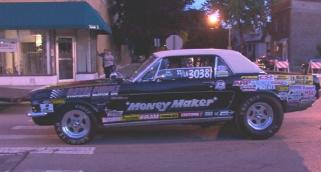This is not gospel but rather a baseline of tuning on old Fords from my own personal experience of the last 25 yrs. This is also assuming that the engine is OK and all plugs are firing properly.When I'm tuning up on a old carbureted street car, first thing I do is check for vacuum leaks, broken vacuum hoses, and open vacuum ports around the body and base of the carb before making any adjustments.
Ignition timing:
First, MAKE SURE that the vacuum advance canister is hooked up and working properly. You can test it by finding a vacuum port that has a good vacuum reading and watch the timing pointer with a timing light as you hook the canister hose up to the vacuum port. The timing should increase as soon as you hook up the hose. If the vacuum advance is not working then fix it or get it fixed.. NEXT, make sure the mechanical advance is working properly by plugging off the vacuum advance and watching the timing pointer as you increase the rpms to 3000. The timing should advance as the rpms increase. If not, hook the vacuum advance back up and get the mech. advance fixed.
If the carb does not respond correctly with the vacuum and mech. advance both working, then you can try this... Increase the timing with the engine running by turning the distributor until the most vacuum is achieved in the intake manifold. Once this is done, turn off the engine and try to restart. The engine may turn over harder, but this is normal. A squirt of gas usually starts it up. There will be a point where the engine will turn over too hard or try to turn backwards when you shut it off. If you reached this point, back off on the timing a little at a time until it cranks and responds to your liking. A correctly timed engine will almost never backfire even when it's running out of gas. Once the base timing is adjusted correctly so the engine is responsive, then you can fine tune the mech. advance, and fuel mixture for cruising and high rpm performance. Ideally, on a normally aspirated engine, you need about 36-40 degrees of total timing when cruising and racing. After the base timing is set then you may have to retune the mech. advance to get the desired timing.
Carburetor tuning:
The original stock jetting and power valve is the best place to start on a new or used carb. Cleaning and NEW gaskets is necessary each time you remove a bowl. A complete rebuild kit is necesary on a used carb unless you have seen it run perfectly on a similar engine. Make sure all old gasket material has been removed carefully before assy. Start with idle screws turned 2 turns out and don't worry about them anymore until you insure engine is responding properly.
All this insures that you don't create unknown problems.
Things to check for poor idle and off idle conditions:
1. As stated above, low ignition timing is the #1 cause of poor throttle response. Adjust and recurve if necessary. Some engines like as much as 20 degrees initial timing or more for good throttle response. You have to experiment as stated above.
2. The squirters must release fuel as soon as you touch the throttle. The adjusting nut and spring in the front right corner of the carb can get turned down too far and this will pull the squirter lever off the pump and cause a delay. Back off the nut until the lever begins to push the squirter pump.
3. If the carb is old or has been sitting up, the low speed air bleeds (little holes on either side the squirters) can get corroded or stopped up and can be cleaned with an orifice cleaner and air hose. If they get restricted, the carb will feel like it is running out of fuel.
4. Low fuel bowl level observed through sight glass. Not as critical as above items , but can cause a lean condition if it gets too low. Engine must be running smooth and level to adjust.
5. Main jets can be sized too small, stopped up with debris, or corroded. This can be a cause of poor off idle response.
6. The power valve can be sized wrong for the vacuum level of the induction system. Normally, vacuum begins to fall to 0 as soon as you crack open the carb. Make sure the power valve size is at least 5 numbers below the lowest vacuum reading taken at idle on a calibrated guage. This ensures that the enrichment circuit is not in until needed.
6. Last thing you can do is check for fuel leaks around and inside of the carb. Outside leaks are obvious, but inside leaks can be detected by running the engine for a few minutes at idle and shutting down without touching the throttle. Then shine a light down on the throttle plates after sitting for about ten minutes. They should be dry. If you notice wetness on the plates then this may be a sign that a block gasket or power valve is leaking from the bowl next to the wet throttle plates.
Note: Secondary linkage rod can be removed on a Double pumper or the vacuum canister rod cam be unhooked on a vacuum sec. carb for easier primary tuning. Secondary tuning is another story.
This is long but it only touches some basic stuff and hopefully this will help someone. 
Dan







 Mustangsandmore Forums
Mustangsandmore Forums

 '64 1/2 to '73 -- The Classic Mustang
'64 1/2 to '73 -- The Classic Mustang

 Holley carb question
Holley carb question


